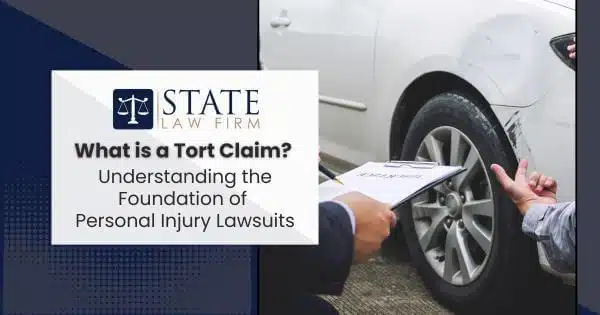When someone is injured due to another party’s careless or intentional actions, the legal system provides a path to seek justice—that path often begins with a tort claim. At its core, a tort claim is the foundation of most personal injury lawsuits, including those involving car accidents, slip and falls, and even defective products. It’s how victims hold wrongdoers legally accountable for physical, emotional, and financial harm.
Understanding tort claims is essential if you or a loved one has been harmed due to someone else’s negligence. Over 400,000 personal injury claims are filed in the United States each year, with motor vehicle accidents being one of the most common sources of litigation [source: U.S. Department of Justice, Civil Justice Survey of State Courts.
Whether you’re recovering from a collision and considering your legal options or gathering crucial traffic camera footage to support your case, knowing how tort law works can help you protect your rights and build a stronger claim. If you’re currently navigating a car accident claim, our dedicated Sherman Oaks car accident lawyers are here to provide clear guidance and aggressive representation.
In this article, we’ll break down what a tort claim is, explain the types of torts, how negligence plays a role, and outline the steps to filing your claim. We’ll also cover key deadlines and help you understand the difference between civil and criminal actions, so you’re empowered with the knowledge you need to take the next step.
Introduction to Tort Claims: Defining the Basics
At its core, a tort claim is a legal action that arises when someone suffers harm due to another person’s wrongful conduct. Tort law is the foundation of most personal injury lawsuits—it governs civil wrongs that result in physical, emotional, or financial damage.
Unlike criminal cases, which are prosecuted by the state, tort claims are brought by private individuals seeking compensation for personal injury or property damage. These claims establish legal liability, ensuring that the person or entity responsible for the harm is held accountable for their actions.
Key elements of a tort claim:
- A duty owed by one party to another
- A breach of that duty
- Causation linking the breach to the harm
- Damages were suffered as a result.
If you’re unsure whether your experience qualifies as a tort, it’s always wise to consult a legal professional early. The attorneys at State Law Firm are here to help you determine the strength of your case.
The Different Types of Tort Claims: Exploring Categories and Examples
Tort claims come in various forms, each with its own rules and standards. Understanding the three main categories can help you determine the right path forward.
1. Intentional Torts
These occur when someone purposefully causes harm. Common examples include:
- Assault and battery
- False imprisonment
- Intentional infliction of emotional distress
- Trespass
2. Negligence Claims
The most common type of tort, negligence, involves careless behavior that results in injury. Examples include:
- Car accidents
- Slip and fall incidents
- Medical malpractice
3. Strict Liability Torts
These apply even when the defendant didn’t act negligently or intentionally but is still legally responsible. This is common in:
- Defective product claims
- Animal attacks
- Hazardous activities
Pro Tip: Even if you’re not sure which category your case fits into, documenting everything—from photos of the scene to medical records—can make or break your claim later.
The Role of Negligence in Tort Claims: Key Concepts Explained
Negligence is the backbone of many tort claims. It occurs when someone fails to act with the level of care that a reasonable person would in the same situation.
Four Key Elements:
- Duty of care: Did the defendant owe you a duty?
- Breach of duty: Did they fail to uphold that duty?
- Causation: Did their actions directly cause your injuries?
- Damages: Did you suffer measurable losses?
Negligence doesn’t require bad intentions—just a lapse in care. For example, a distracted driver who runs a red light and causes a crash could be liable for negligence, even if they didn’t mean to hurt anyone.
If you’ve been injured in an accident and suspect negligence played a role, our Sherman Oaks car accident lawyers are ready to evaluate your case and guide you toward compensation.
How to File a Tort Claim: A Step-by-Step Guide for Victims
Filing a tort claim may seem daunting, but with the proper preparation, it’s entirely manageable. Here’s a general roadmap to follow:
Step 1: Seek Medical Attention
Prioritize your health—your treatment records will also be key evidence.
Step 2: Gather Documentation
Start collecting:
- Photos of injuries and the scene
- Police or incident reports
- Medical bills and treatment summaries
- Traffic camera footage (if applicable)
Step 3: Consult a Personal Injury Attorney
An experienced attorney can assess your claim, gather evidence, and negotiate with insurance companies on your behalf.
Step 4: File the Claim
Depending on your case, this may involve submitting a demand letter, filing court paperwork, or negotiating a settlement.
Pro Tip: Don’t go it alone. Insurance companies often downplay your injuries or rush you into a lowball settlement. Having a legal team in your corner makes all the difference.
The Importance of Statute of Limitations in Tort Claims: What You Need to Know
Every tort claim is subject to a statute of limitations—a legal deadline for filing your case. Miss it, and you could lose your right to compensation altogether.
In California, the statute of limitations for most personal injury claims is two years from the date of injury. However, exceptions can apply (especially in cases involving minors, government entities, or delayed discovery of harm).
Common impacts of missing the deadline:
- Your case may be thrown out entirely
- The defendant can raise the statute as a defense.
- You may lose leverage in settlement negotiations.
Pro Tip: Don’t wait. The sooner you speak with an attorney, the more time you’ll have to preserve evidence and build a strong case.
Tort Claims vs. Criminal Charges: Understanding the Differences
It’s common to confuse civil and criminal cases, especially when both stem from the same event (like an assault or DUI accident). Here’s a quick breakdown:
| Aspect | Tort Claim (Civil) | Criminal Charge |
| Purpose | Compensation for the victim | Punishment for the offender |
| Who files? | Private individual | Government prosecutor |
| Standard of proof | Preponderance of the evidence | Beyond a reasonable doubt |
| Outcome | Damages awarded | Fines, jail time, probation |
In some situations, both actions can happen simultaneously. For example, someone who causes a crash while intoxicated may face a criminal DUI charge and a civil tort claim for damages.
At State Law Firm, we’re focused on helping victims get justice and recover the compensation they deserve—even if the criminal system falls short.
Navigating Your Rights and Options with Tort Claims in Personal Injury Law
Understanding tort claims is the first step toward reclaiming control after an injury. Whether you’re navigating life after a serious car accident or dealing with emotional distress from someone else’s actions, the civil justice system offers a path to recovery.
At State Law Firm, we combine fresh legal talent with a deep commitment to helping our clients get results—no matter how complex the case. If you’re unsure about your next steps, we’re here to break it down, advocate fiercely, and walk you through every phase of the legal process.
Let’s talk about what happened and where you go from here.


